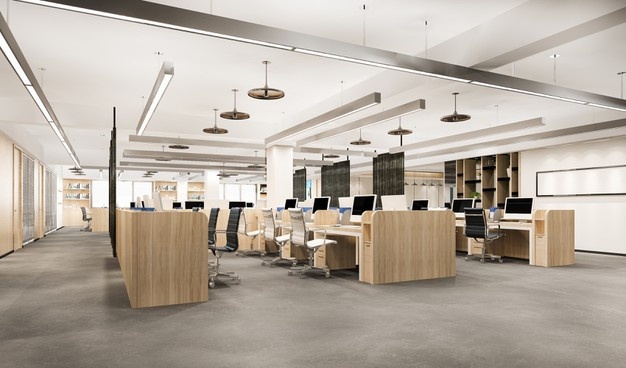What are the top 7 elements of commercial interior designing?

When you hear the term commercial interior designer, what comes to your mind first? I think most of us imagine a picture of a designer with some instrument in hand doing wooden work. Right?
But, commercial interior designers do more than creating office interiors; they design beautiful interiors for hotels, bars, restaurants, gymnasiums, retail shops, etc., and are also capable of renovating the same. To get the best interior designing services, check out Menatworkdesign, known as the best commercial interior designer in Delhi and nearby locations. No doubt, interior designers are very creative. Creativity blended with experience can create wonders. These creative designers follow a set of rules based on a few principles and elements. These principles and elements are necessary to give a fine touch to any commercial interior design. Every interior designing agency in India, especially some qualified commercial interior designers in Delhi keeps these elements in mind while planning for the interior. These elements include space, light, form, line, pattern, texture, and color. Combining these seven elements at the stage of planning or before execution can result in wonders. Let us check them out and understand their importance.
1. Space
This is the foundation of the interior designing work on which the rest of interior design is based. Space can be anything; it can be a room, a lobby, balcony, hall, etc. The commercial interior designer must have all the details and measurements about the available space. It will be easier for him to plan the interior accordingly. Normally, space is of two types:
2-D Space: This space or area constitutes the length and breadth of the available floor area of the room, the hall, or any space.
3-D Space: A three-dimensional space constitutes the length, breadth, and height of the given space. Apart from dimensional categorization, they can be categorized into positive and negative spaces. Positive spaces are the area filled with various design stuff and are not empty. While negative spaces are the vacant space elements.
2. Light
Light plays a crucial role in designing the perfect commercial interior of any office, gym, restaurant, etc. Commercial interior designers in Delhi-NCR with their creative approach can effectively target certain areas with proper lighting and enhance the beauty of that space. Light has a major significance in highlighting patterns, color, texture, form, and lines of the interior. Moreover, it should be selected based on the activities that shall be undertaken in the space. E.g. An office must have some bright lighting all over the space so that the employees can see and work with their full efficiency. Two types of lights are generally considered in commercial interior designing:
Natural Light: It’s what we receive directly from the sun. Open windows, curtains, wall glasses, etc. are considered great mediums for natural lighting.
Artificial Light: These are the man-made lights used where the natural light can’t reach. These are of three types.
- Mood Light: These are used to illuminate the particular space and set the mood of the living space.
- Task Light: These are used for any specific purpose. E.g. A table lamp
- Accent Light: It enhances the beauty of the existing spaces. E.g. light is thrown on a fountain, wall, painting, etc. Based on the location and the requirement, commercial interior designers in Delhi choose light accordingly.
3. Forms
The form implies a shape in space. A form can be two-dimensional or three-dimensional. Generally, they are of two types:
Geometric Forms: These are man-made forms with circle, square, and hexagonal shapes.
Natural / Organic Forms: Forms that are natural and don’t possess a particular shape and lining. E.g. Plants, clouds, animals, etc.
4. Lines
Lines are also considered as one of the key elements in commercial interior designing. Menatworkdesign, a qualified commercial interior designer in Delhi plans their design by considering lines, shapes, and other fundamentals. The most commonly used lines are:
Horizontal Lines: These lines are used on the floors to make a hall look bigger and wider. Tables, chairs, sofas, and other furniture are used to make horizontal lines.
Vertical Lines: Created by windows, doorways, etc., and make a wall look taller.
Dynamic Lines: These are zigzag, diagonal, or curved lines and are mostly found in stairs and other curved structures.
5. Colors
Colors are something that can’t be neglected at all. Colors are powerful ingredients in commercial interior designing and reflect the brand’s identity, purpose, and creativity and can create mood & alter perception about the size of the space. Choosing the right color for the right space is not everyone’s cup of tea; the expert is recommended to perform such critical tasks. Every color has three major elements: Intensity, Hue, and Value. Each experienced commercial interior designing firm in Delhi-NCR is aware of these fundamental elements and by performing some permutation & combination with the texture, they established something that looks attractive and creative. Interior designers categorize these colors as Primary and Secondary, and then further sub-categorize them as Tertiary, Complementary, Analogous, and Monochromatic.
6. Patterns
Patterns are something that dictates a story and gives life & motion to the interior. They are created by using repetitive designs and can be found on wallpapers, furnishing, floorings, fabrics, etc. Restaurants and bars use some great patterns to create an atmosphere of joy & good vibes. Creating too many clashing patterns can give a chaotic look and doesn’t look appealing at all. So, whenever you want some patterns, consult your interior designers well.
7. Texture
The texture is the way an object looks or feels to touch or by simply observing. In simple language, texture defines how an object feels to touch or how it looks when sensing or looking at it. In-office interior, a great texture can be given to tables, chairs, cabin doors, sofas, floors, etc. A great texture surely looks pleasing and adds interest. Generally, two types of texture are there: Visual and Actual. Visual texture can be perceived by the eyes or can be felt just by looking at it. While Active texture is visible and can be felt too. Visit Menatworkdesign for any type of commercial interior design services. We have been regarded as the best commercial interior designing firm in Delhi-NCR. With an expert panel of engineers, our team is capable of turning your imagination into reality.



